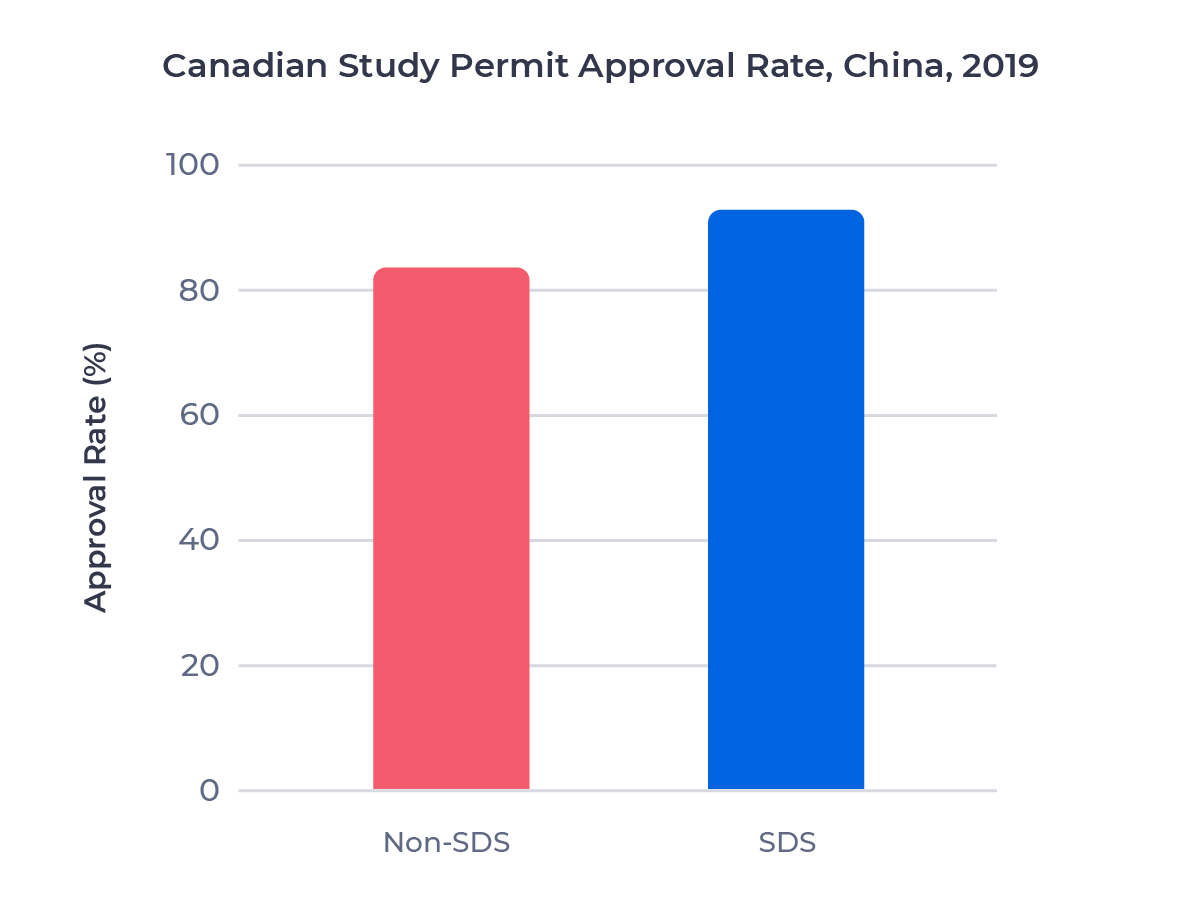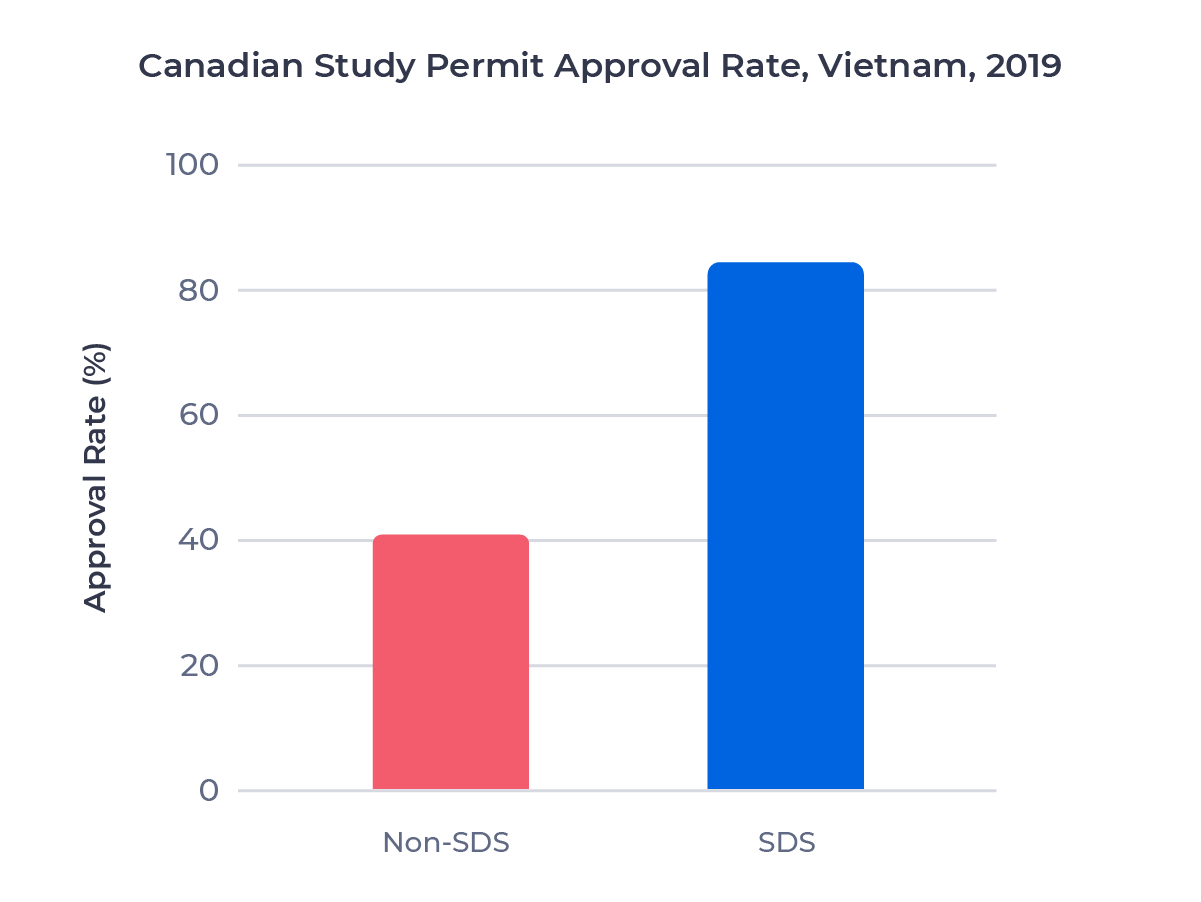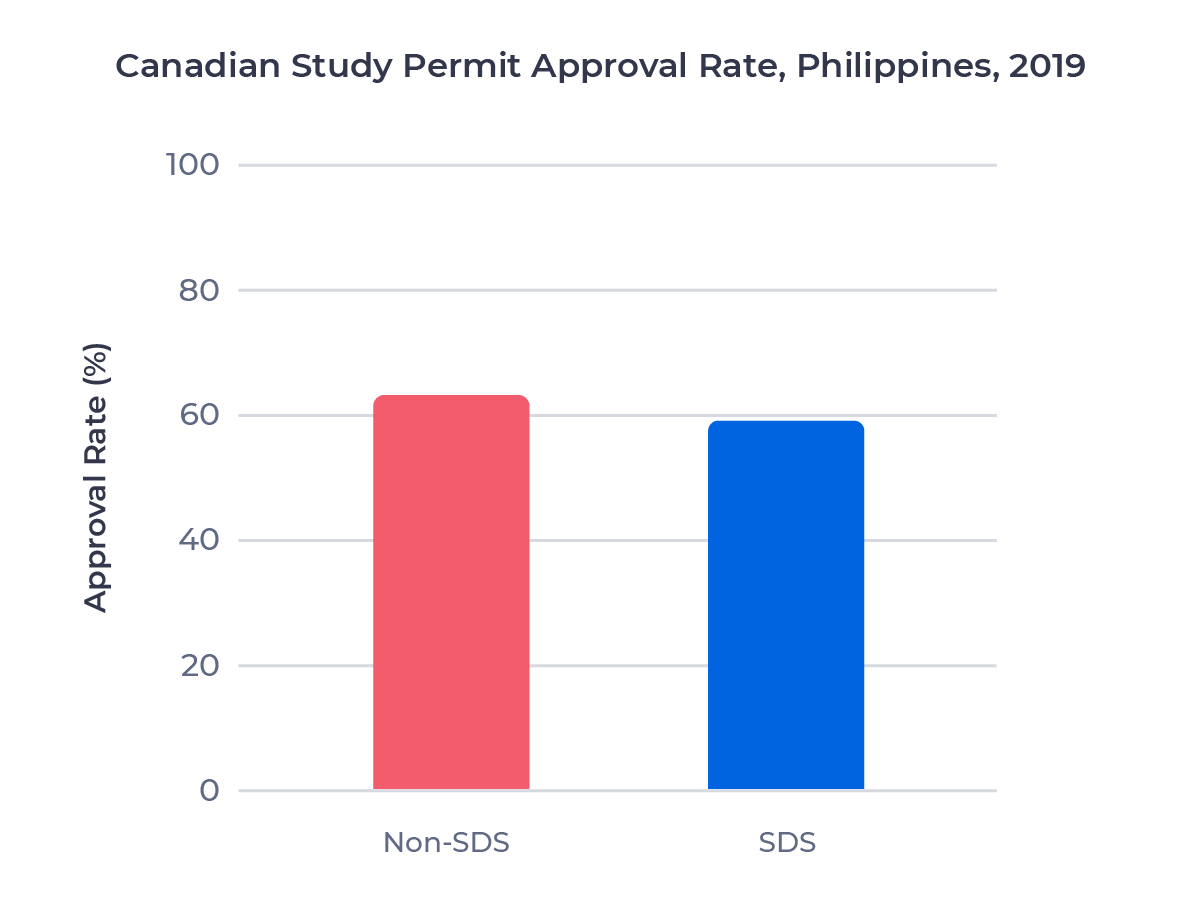In today’s ApplyInsights, I’m continuing my dive into the data on Canada’s Student Direct Stream (SDS). SDS is a government program that allows eligible international students from select countries to expedite the processing of their Canadian study permit. This article focuses on trends in the SDS program for students from China, Vietnam, and the Philippines.
Check out the previous ApplyInsights for my thoughts on SDS and the India market.
Here’s what this blog post will cover:
- Study permit approval rates for Chinese, Vietnamese, and Filipino students applying through the SDS program and the regular stream
- A breakdown of SDS and non-SDS approval rates for Chinese, Vietnamese, and Filipino students by study level and program
- Some thoughts from Hari Ghai, ApplyBoard’s Senior Immigration Consultant and a Regulated Canadian Immigration Consultant (RCIC), on when students should apply through SDS versus the regular stream
SDS is only available for post-secondary students applying to a designated learning institution (DLI). Applicants must meet a series of criteria to be eligible for SDS processing. However, Immigration, Refugees and Citizenship Canada (IRCC) processes most applications within 20 calendar days if the eligibility criteria are met.
For more information on SDS, check out our guide to the program.
In our previous article, we saw that Indian students accounted for 95.4% of all SDS applicants in 2019. Chinese, Vietnamese, and Filipino students made up almost all of the remaining 5.6%.
Let’s take a look at those three countries in more detail.1
SDS and Study Permit Approval Rates – China
China is Canada’s second-largest source market for international students. However, only a tiny fraction of those looking to study in Canada applied for a study permit through the SDS program last year. In total, 1,653 Chinese citizens applied through SDS, accounting for just 2.0% of SDS applicants.
Why was there so little uptake of the SDS program among Chinese students? The lack of interest may reflect the SDS eligibility criteria.
SDS applicants must have the following:
- An International English Language Testing System (IELTS) score of 6.0 or higher across all four categories of proficiency: reading, writing, speaking, and listening2
- Proof of a guaranteed investment certificate (GIC) of C$10,000 or more
The language proficiency requirement for SDS is high, and can be difficult to meet for many Chinese students. Conversely, the GIC requirement allows students to provide proof of financial support without having to demonstrate a substantial history of funds. But this is rarely an issue for Chinese students, who are typically well funded and have parental support.
ApplyBoard’s Senior Immigration Consultant, Hari Ghai, encourages students who don’t quite meet the SDS requirements for language proficiency but show a strong history of funds, as many Chinese applicants do, to apply through the regular stream, where he believes they’d be competitive. Hari also encourages these students to highlight strong grades in other areas, such as mathematics and the sciences.
The data shows that most Chinese students are approved for a study permit:
The fact that Chinese students were only somewhat more likely to be approved through SDS aligns with a trend we observed in the Indian data. There are diminishing returns in the marginal approval rate for students applying for programs with higher approval rates for the regular stream.
This may also factor into the lack of interest in the SDS program, as students and recruitment agents see strong approval rates through the regular stream and little incentive to apply through a newer, more rigorous program.
SDS vs. Non-SDS Approval Rates by Study Level
This trend carried through for individual study levels, as well. The table below shows the approval rates for applicants to bachelor’s and master’s programs:3
| Program | Non-SDS Approval Rate | SDS Approval Rate | Difference |
|---|---|---|---|
| Bachelor’s | 91.5% | 96.4% | +5.0% |
| Master’s | 88.1% | 94.1% | +5.9% |
Again, we see elevated regular stream approval rates and only slightly higher approval rates for SDS applicants. At both the country level and the program level, the marginal approval rate for SDS applicants appears to decrease as the regular stream approval rate increases.
Because of the limited uptake of the SDS program in China and the Chinese market’s preference for university education in Canada, there isn’t enough data to make meaningful observations about the Chinese college market on a program level.
SDS and Study Permit Approval Rates – Vietnam
Vietnam is Canada’s fifth-largest source market for international students. 1,265 Vietnamese citizens applied for study permits through SDS in 2019, accounting for 1.6% of SDS applicants.
Comparing approval rates through the SDS program with those through the regular stream, we have the following:
SDS vs. Non-SDS Approval Rates by Study Level
Let’s turn to the university numbers. The table below shows the approval rates for Vietnamese applicants to Canadian bachelor’s and master’s programs:
| Program | Non-SDS Approval Rate | SDS Approval Rate | Difference |
|---|---|---|---|
| Bachelor’s | 69.8% | 95.5% | +25.7% |
| Master’s | 67.3% | 89.0% | +21.7% |
As with India and China, both the SDS and regular stream approval rates are higher for university programs than the overall average. The SDS numbers are particularly robust, but again, we see diminishing returns in the marginal rates.
College applicants, in contrast, had much lower regular stream approval rates and saw a much larger boost by applying through SDS:
| Program | Non-SDS Approval Rate | SDS Approval Rate | Difference |
|---|---|---|---|
| Applied Degree | 28.6% | 78.8% | +50.3% |
| Certificate | 20.7% | 68.6% | +48.0% |
| Diploma | 36.3% | 86.4% | +50.2% |
SDS and Study Permit Approval Rates – Philippines
The Philippines was the smallest of the four markets originally included in SDS, and it saw the fewest SDS applicants last year. 782 Filipinos applied for a study permit through the SDS program in 2019, good for an even 1.0% of the SDS market.
Unlike the other three countries we’ve profiled, the Philippines actually saw a dip in approval rate among SDS applicants versus the regular stream:
SDS vs. Non-SDS Approval Rates by Study Level
Due to the relatively small number of SDS applicants from the Philippines, there isn’t enough data to make meaningful observations about the Filipino university market on a program level. Reviewing the college data, we have the following:
| Program | Non-SDS Approval Rate | SDS Approval Rate | Difference |
|---|---|---|---|
| Certificate | 66.5% | 60.8% | -5.7% |
| Diploma | 61.7% | 57.2% | -4.5% |
Approval rates were slightly lower through SDS than the regular stream for both certificate and diploma programs,4 in line with the cross-sector totals.
Summary: SDS vs. Regular Stream
Before we conclude, let’s recap our findings:
- Application numbers to the SDS program from Chinese students in 2019 were low, potentially reflecting difficulties meeting the language requirement.
- Approval rates for Chinese students in 2019 were only slightly higher through SDS than the regular stream, in part because approval rates for the regular stream were already high.
- Vietnamese students were roughly twice as likely to be approved for a study permit through SDS than the regular stream in 2019.
- Applying through SDS provided a much larger boost for Vietnamese students applying for college programs than students applying for university programs.
- Filipino applicants had lower approval rates for the SDS program than for the regular stream. This may reflect small-sample variance.
Final Thoughts
The SDS program was a significant development in the Government of Canada’s approach to international education when it was introduced in June 2018.
SDS marked a move towards a more standardized second stream for high-quality applicants to Canadian schools. We’ve seen huge uptake in India, where SDS has expedited processing times for tens of thousands of applicants over the past two years. But in other markets, such as China and the Philippines, it’s been less of a fit.
With the program expanding to Pakistan, Morocco, and Senegal last year, it’s safe to say SDS is here to stay. The program will likely continue to expand as the government looks to attract students from a more diverse range of countries.5 In particular, if SDS has success in Morocco and Senegal, I suspect we’ll see the program expanded to other Francophone African nations, such as Algeria and Tunisia.
Like the regular stream for study permit approvals, SDS numbers were hit hard in 2020 by the COVID-19 pandemic. While this may make analysis of long-term program trends more difficult, I expect we’ll see participation in the program recover and even rise as recruitment agents in the relevant source markets become increasingly familiar with which students are best suited to the program.
Subscribe to ApplyInsights
Sign up for the latest insights on international education.
 Meti Basiri
Meti Basiri
Co-Founder and Chief Marketing Officer (CMO)
Meti is driven by the belief that education is a right, not a privilege. In his role as Co-Founder and Chief Marketing Officer (CMO) at ApplyBoard, he leads the International Recruitment, Partner Relations, Sales Enablement, Sales Operations, and Marketing teams along a shared mission to educate the world. Meti has been instrumental in building partnerships with 1,200+ educational institutions across North America, the United Kingdom, and Australia. Working with over 4,000 international recruitment partners, ApplyBoard has assisted more than 120,000 students in their study abroad journey.
Meti was honoured in 2019 by Forbes, being named to three Top 30 Under 30 lists, including Education, Immigrants, and Big Money. Follow Meti on LinkedIn for more access to ApplyInsights and key industry trends.
FOOTNOTES:
1. This article examines 2019 data only. Though Q1 and Q2 2020 data is available, only a small number of students from China, Vietnam, and the Philippines applied for a Canadian study permit due to restrictions and challenges associated with the COVID-19 pandemic.
2. For applicants to English-language programs. Applicants to French-language programs must provide a Test d’Evaluation de Français (TEF) score of at least 207 for reading, 310 for writing, 310 for speaking, and 249 for listening.
3. Not enough Chinese students applied through SDS for doctorate or other studies programs for ApplyInsights to conduct a meaningful analysis.
4. Not enough Filipino students applied through SDS for applied degree programs for ApplyInsights to conduct a meaningful analysis.
5. For details on this initiative, see Canada’s International Education Strategy (2019-2024).



